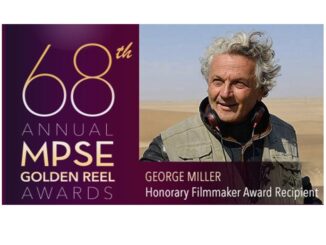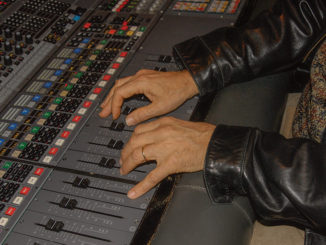
By Su Fang Tham
David E. Kelley’s courtroom miniseries “Presumed Innocent” opens with the confident and seemingly decent attorney Rusty Sabich (Jake Gyllenhaal) delivering a closing argument at trial. His words set up the central conceit of the series: “I will present evidence to show you that the accused committed this crime. Now, should you find that to be very likely, you have to set him free. My job is to prove guilt beyond a reasonable doubt,” he says.
In this courtroom psychological drama from Apple TV+, Rusty’s idyllic home life—with wife Barbara (Ruth Negga) and two teenage children—is upended when he is accused of killing his lover and fellow prosecutor, Carolyn (Renate Reinsve), after she is brutally murdered and found hog-tied in her house. Re-recording mixers Larry Benjamin and Chuyue Christina Wen helped sustain the ambiguity surrounding Rusty’s role in the murder to keep the audience guessing until the very end.
Frequent flashbacks unravel Rusty’s motivations and details behind the affair. But each time, “Rusty becomes a very unreliable narrator: he keeps changing his story. As he tells it in different scenes, it’s sonically and visually being re-told,” Benjamin said.
Wen added: “The dream space and flashbacks were the most rewarding to mix for me. For the flashbacks, we did a lot of work along with the sound editorial team to subtly trick the audience into questioning Rusty’s story.”
CineMontage: Even though this story takes place in present day, we don’t have much that puts it firmly in the 2020s, aside from the iPhones. There is hardly any mention of social media even though the Sabich children are teenagers. At one point, Rusty and Barbara dance to Patsy Cline’s “Crazy” in a flashback to better days. How did sound play into that retro vibe?
Larry Benjamin: That’s true, it’s like a vintage, vibey show. Trevor Baker is a wonderful lead picture editor who worked with us in the sound mix; we did a lot of this with music. We made viewers feel uneasy by changing the pitch to make the song sound like an old record. You hear record scratch noises. The recording was initially pristine, and Christina added that surface noise to make it sound like a record. You don’t really notice it, but you feel uneasy.
CineMontage: How did you make it sound like Chicago when the show was mostly shot in Pasadena?
Chuyue Christina Wen: In every wide shot of the city where we see the trains, our sound supervisor Nick Forshager and sound effects supervisor, Scott Sanders, made sure I had the correct sound for the train to make it feel like we’re really in Chicago.

Benjamin: The biggest thing was selling Chicago and the suburbs, where Rusty’s family lives. We had rolling thunder, rainstorms, the ‘L’ train, an occasional jet plane or helicopter overhead, buses, and sirens. They’re distant, not so much that it distracts from the story, but subconsciously to show we’re in an urban city.
CineMontage: Much of this story takes place inside the prosecutor’s office, Rusty’s house, or the courtroom. How do you keep them sounding like real living spaces?
Benjamin: We kept the city alive when we’re indoors too. Greg Yaitanes, the directing producer, didn’t want it to be anechoic. So, we hear the kids upstairs or someone’s listening to music. Barbara’s doing laundry—we don’t see it, but maybe there’s a pair of sneakers tumbling in the dryer. These mundane sounds sell that it’s an actual living place. The prosecutor’s office is very busy, so we signaled the time of day with the density of people.
CineMontage: How do you make a mundane courtroom sound alive?
Wen: We used sound to trick the audience. Nick and his Foley team, including Foley mixer Ron Mellegers and Foley editor, Brad Bakelmun were amazing. My job was to treat those Foleys. A courtroom reverb makes those Foleys feel like they’re happening in the courtroom and the “surround verb” sells the size of the room. The match reverb matches Foley to production quality so it sounds realistic. I worked closely with Larry to make sure my Foley received the same treatment as the dialog. Foley needs to match the quality of the production sound and match the ambience and size of the room.
Benjamin: We kept the people in the courtroom alive even though they’re not talking, through coughing or throat-clears with reverb. When people shift in their seats, we had a sound cue—the church pews type of sound, with the wood creaking. You hear that clickety-clack of the stenographer machine. I added reverb to their voices. There was always one camera shooting wide, which means there wasn’t a lot of boom. So, I relied heavily on the lavalier microphones to sell distance and perspective. The Stratus 3D has a very good lush reverb.

CineMontage: As the evidence pile up against him, the only time that Rusty can strategize and clear his head is when he goes swimming. Talk about sonically treating those scenes.
Wen: When he’s in the swimming pool and thinking about Carolyn, it sounds like we’re submerged underwater with this ruffly effect to the reality, which convinces the audience that we’re inside his mind. That underwater sound design comes up often when he thinks about her. With the series being ATMOS, I have water surrounding your head. Every time Rusty thinks about Caroline, we’re drowning in that memory with him.
Benjamin: When he’s swimming, Rusty centers himself and gets into a meditative state, and we see things through his prism. Scott provided a lot of the sound design for those flashbacks. We also used those water sounds outside the pool during flashbacks. That’s what I call “going into the soup,” when we muffle the dialog and other sounds to make them reverberant, kind of “soupy,” to get into his headspace. We combined discordant sounds with the score to create a sense of unease.
CineMontage: What was it like to work on the discordant music cues as the walls start to cave in on Rusty?
Benjamin: This was a unique show. Normally, music would be vetted and I wouldn’t even get stems, just a finished stereo composite. But we had a very compressed timeline, the producers didn’t get to hear the score or cues until the playback pass. So, Trevor and I worked on this more than we usually would on the mix stage. We were given 10-16 different stems primarily from the composers, like the percussion stem, orchestral stem, synthesis stem, drums, bass, and then we added layers like stabs, hits, etc. Then, we sent it to [music editor] Dean [Menta], who mocked up changes, extended the cues as needed, and did anything that we didn’t cover on the stage.
CineMontage: What were some of the more challenging scenes to nail down with music?
Benjamin: In the pilot, Rusty gets the call about Carolyn’s murder and he tells Barbara very quickly before rushing to the crime scene. That sequence had 10 different iterations and arrangements sonically. But [executive producer] J.J. [Abrams] wanted the melody to be clear and set up what the show would be like. He wanted it to be intriguing and draw you in musically. So, we took a cue intended for a later scene with simplified piano notes and repurposed it here to convey where we were in Rusty’s headspace, which became a template to recompose the cue from scratch. Another big music moment is in the finale. As everyone gets ready for the verdict, the music rises, gets more frenetic and intense, and then releases once everyone sits down in the courtroom.
CineMontage: The frenzied flashbacks to their affair goes from violent and ferocious to salacious. How did you convey the obsession, frustration, love, and anger between these lovers?
Benjamin: We wanted to keep it very organic and carnal between Carolyn and Rusty. Nick’s co-supervisor, Kathryn Madsen, is a terrific ADR supervisor, and she cut little bits of breaths and efforts when they were moaning, and I added reverb. As the scene intensifies visually, we’re doing the same sonically; some of that’s from production too. Anytime he sees Carolyn’s body tied up in a flashback, we accentuated the stressing strain of the hemp ropes. The Foley crew took a rope and stretched it to make that sound. When they’re embracing or having very passionate sex, where furniture was thrown around, we added bed squeaks.
CineMontage: In one of the frantic moments, a potential suspect in an old case, Brian (Marco Rodríguez), comes banging on Rusty’s door and scares the family, and Rusty beats him up.
Wen: It’s very intense and chaotic. Rusty is freaking out because he just got a call from Raymond about new evidence that could tie him directly to Carolyn’s murder. The camera is panning in Rusty’s perspective around the house and he sees that his daughter Jaden [Chase Infiniti] is scared. When we pan back to the door, sound followed the camera and panned all around the room to create this chaos. ATMOS is very immersive and allows us to be more directional and intentional with panning. When he starts punching Brian, the punches get bigger before we go into Rusty’s headspace, where it’s almost like he’s lost himself and doesn’t know what he’s doing anymore. So, as he’s punching Brian, we had reality sucked away. You feel the punches in your chest but we don’t hear any punching sounds anymore.
CineMontage: In the pilot, we have a few heartbreaking scenes after Barbara forces Rusty to tell the kids about the affair. Then, he sits alone at the base of the staircase listening to her comfort the kids before Jaden confronts him about why he cheated on mom.
Wen: I pulled some of the sound elements away very slowly to make you feel like the air is getting sucked out of the room. Production captured a lot of the movements, but anything that’s not covered, I added those in, like a hand padding someone on the arm, or when they’re turning to each other. Less is more in these sad moments, to make you feel intimate with these characters and experience their feeling.
CineMontage: Throughout the eight episodes, we are never sure whether Rusty could have done it. What were the sonic tricks that played with his culpability?
Benjamin: They had pre-laps, post-laps, and parallel edits, like when Rusty is sitting in his car thinking and there is audio from the next scene. That plays with the timeline editorially to mess with your sense of time and place.
Wen: In the flashback to the night of the murder when [defense attorney] Mya [Gabby Beans] grills him to prepare for his testimony, that’s the first time we see him pounding on Carolyn’s door from his POV. We’ve seen it many times, but each time, we play the sound a little differently. Trevor came up with the idea of including sounds from this scene when he’s alone at the bar before he goes to her house. He’s coming up with different perspectives of his memory. Is Rusty making up his memory or actually having a hard time remembering? We also had different versions of how he enters her house. In one of them, he pounds on the door violently—he was angry because she wanted to end the relationship. In another flashback through his POV, he rings the doorbell instead, which was almost romantic, like he’s there to make peace. I panned the door knocks in different directions and added dreamy reverb so it feels like we’re in the past with him.
Benjamin: You don’t know what really happened. Did Carolyn slap him? Did he push her? Did he knock on the door or ring the bell?
Wen: There are two narratives told through sound—the violent entry versus the romantic doorbell ring—to make the audience wonder: which story is real?







Be the first to comment